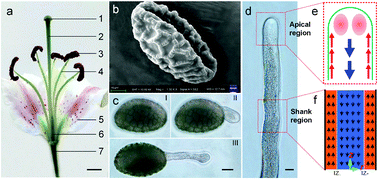Fountain streaming contributes to fast tip-growth through regulating the gradients of turgor pressure and concentration in pollen tubes†
Abstract
Fountain streaming is a typical microfluidic pattern in plant cells, especially for cells with a high aspect ratio such as pollen tubes. Although it has been found that fountain streaming plays crucial roles in the transport of nutrients and metabolites, the positioning of organelles and the mixing of cytoplasms, its implications for the fast tip growth of pollen tubes remain a mystery. To address this, based on the observations of asiatic lily Lilium Casablanca, we developed physical models for reverse fountain streaming in pollen tubes and solved the hydrodynamics and advection–diffusion dynamics of viscous Stokes flow in the shank and apical region of pollen tubes. Theoretical and numerical results demonstrated that the gradients of turgor pressure and concentration of wall materials along the length of pollen tubes provide undamped driving force and high-efficiency materials supply, which are supposed to contribute to the fast tip-growth of pollen tubes. The sample experimental results show that the tip-growth will be abnormal when the gradients of turgor pressure change under osmotic stress induced by different concentrations of PEG-6000 (a dehydrant).



 Please wait while we load your content...
Please wait while we load your content...